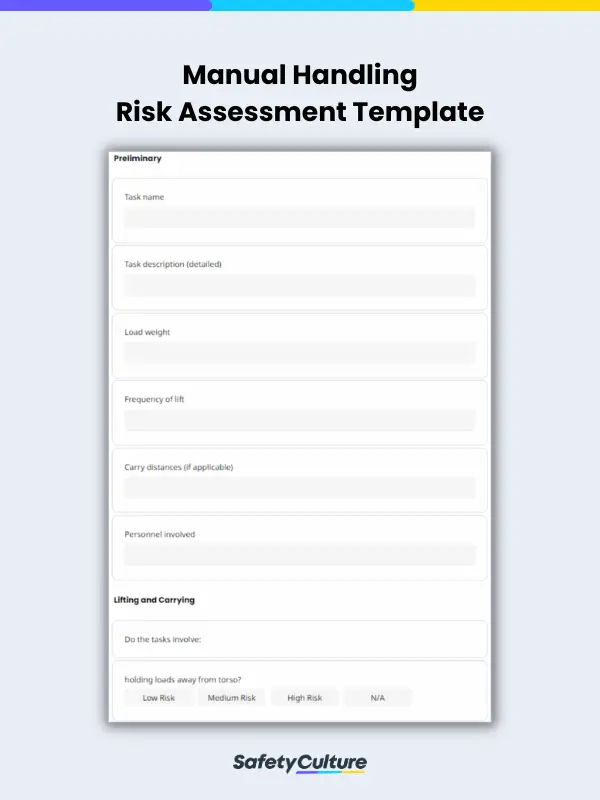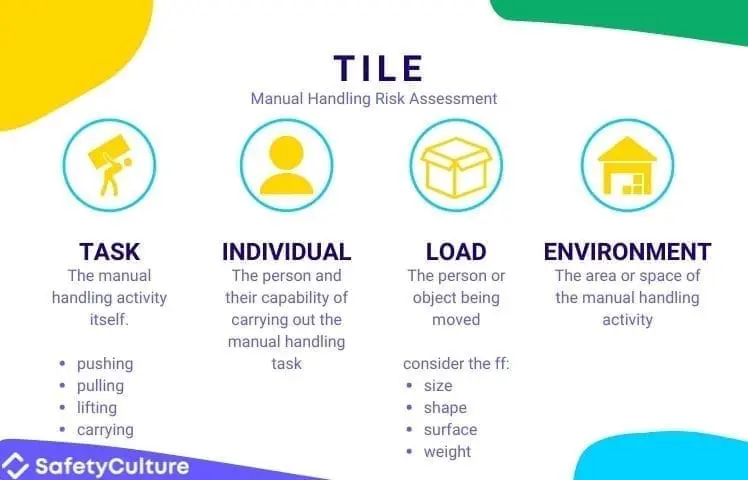What is Manual Handling Risk Assessment?
Similar to a regular risk assessment, a manual handling risk assessment is carried out to identify and evaluate risk factors. Specifically activities of lifting, putting down, carrying, moving, and handling objects during work operations. It is primarily carried out by health and safety officers. Once a manual handling risk assessment is completed, health and safety workers work to develop processes and preventive measures. Assessing manual handling risks is crucial to protect workers from musculoskeletal disorders (MSDs), increase job satisfaction, and improve quality of work.
When is a Manual Handling Risk Assessment Required?
The Health and Safety Executive (HSE) reports that a third of workplace injuries are caused by manual handling. HSE warns workers and employers to avoid manual handling if possible to prevent injuries. In situations where manual handling cannot be avoided, it is recommended to mitigate the risk of injury by putting safety measures in place. One such safety measure is to conduct a risk assessment for every task that can potentially be risky or hazardous.
The Manual Handling Operations Regulations 1992 aims to protect the personnel in charge of manual handling activities such as lifting and lowering. This amendment covers areas for health and safety measures as well. These measures are divided into 3 parts. First is to avoid manual handling activities as much as possible. Second is to do a risk assessment of any manual handling activities that can’t be avoided. Lastly, reduce risks and eliminate any possible workplace injury.
How do you carry out a manual handling risk assessment?
Risk assessments are considered to be a normal process to have a successful manual handling operation. As previously stated, businesses are required to carry out a manual handling risk assessment when there’s possible risk of injury. They are responsible for establishing processes and preventive measures from the results. Every type of risk assessment has something in common. Here are the steps adapted from HSA’s guide on how to conduct a manual handling risk assessment:
- Determine the task – Ask the workers how the task is done. Establish the scope of the manual handling activity and its important stages. This helps pinpoint the exact moment an injury may happen.
- Retrieve essential information – This includes technical information such as load factors of TILE. Load factors to consider are the weight, size, and shape. Another essential information is knowing what postures will the worker be in, size of the space, number of manual handling tasks, and the employee’s technical knowledge.
- Determine the risk factors – Find out the hazards and risk factors. Every factor needs evidence on why it’s a potential risk for the manual handling activity.
- Identify potential improvements – Consult with the personnel using the objective results of the manual handling risk assessment. These improvements should reduce or prevent injury due to manual handling activity. HSA suggests developing a safe system of work plan and to use equipment when possible.
- Review the changes – A staff member should do regular inspections to check the effectiveness of the implemented improvements. Risk assessments are a continuous process that should be updated regularly and revised when necessary.
4 Key Areas of Manual Handling
When performing manual handling risk assessments, the assessor mainly focuses on the 4 key areas of manual handling which is often referred to as the acronym TILE (Task, Individual, Load, and Environment), this can also be referred to as LITE. In some safety circles, “other factors” have been identified as another key area for evaluating manual handling risks, turning the assessment method into TILEO (Task, Individual, Load, Environment, and Other factors).
Manual Handling Hazards
A hazard in manual handling usually means any source that can expose workers to the risk of MSDs and other injuries. Upon identifying hazardous manual handling, assess the risks and mitigate them according to the hierarchy of controls and by conducting manual handling toolbox talks. The most common moving and manual handling hazards as categorized by TILEO:
- Task: Manual handling tasks that are too strenuous, involves long distances, and availability of rest and recovery.
- Individual: This involves the worker’s capabilities such as no training, lack of experience, unfamiliar with the job, physical capabilities, and prior history of injuries.
- Load: This risk can be caused by objects that are too heavy, too large, difficult to grasp or reach, obscures the worker’s view, and unbalanced, unstable or if its contents can move.
- Environment: Hazards because of insufficient work space, uneven or slippery floors, unstable platforms, heat stress, and poor lighting.
- Other factors: monotonous tasks at a high pace and prolonged work without resting, among others.
Example of Manual Handling Risks
Generally, the risk factors for manual handling follow the principle of direct correlation. For example, if the frequency, magnitude, or duration of hazardous manual handling increases, then the risk of being injured also increases, as well as the need for more effective control measures or higher levels in the hierarchy of controls. According to SafeWork Australia, the characteristics of hazardous manual tasks involve:
- Repetitive Force – lifting and stacking goods onto a pallet
- Sustained Force – carrying objects over long distances
- High Force – lifting, lowering, or carrying a heavy object
- Sudden Force – throwing or catching objects
- Repetitive Movement – lifting goods from a conveyor belt and packing them in a carton
- Sustained Posture – supporting plasterboard sheeting while it is nailed into place
- Awkward Posture – squatting while servicing plant or a vehicle
- Whole-body Vibration – operating mobile plant such as heavy earth moving machinery
- Hand-arm Vibration – using impact wrenches, chainsaws, jackhammers, grinders, and drills (click here to learn more about HAVS: Hand-arm Vibration Syndrome)



